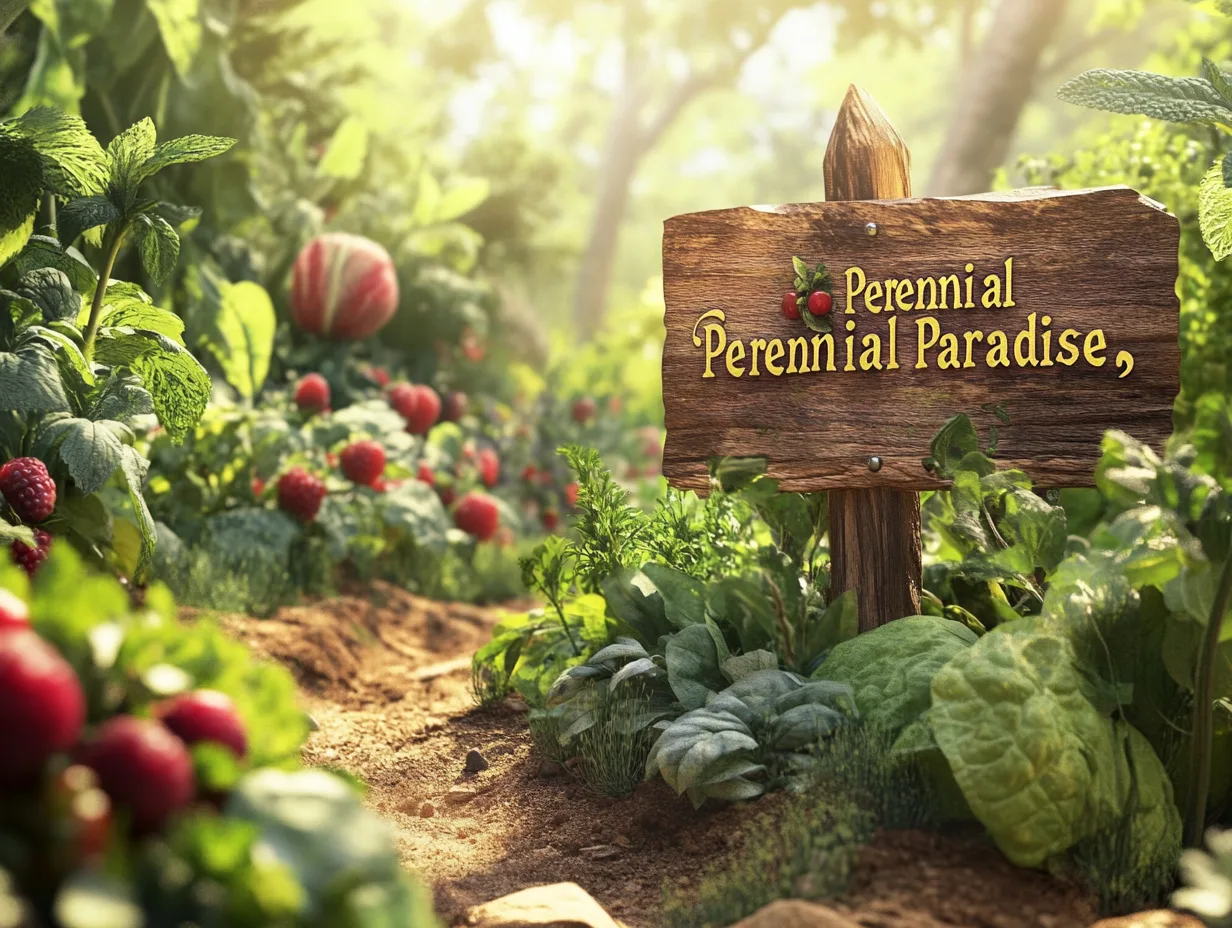Edible perennials are a cornerstone of a self-sustaining garden, offering year-after-year harvests while reducing maintenance and resource input. In this comprehensive guide, we explore why these long-lasting plants are a smart choice for sustainable gardening, review some of the best edible perennials to consider, and provide practical tips for integrating them into your garden design. Emphasizing the keyword Best Edible Perennials throughout, this post will help you create an eco-friendly, low-maintenance garden that feeds both your body and the planet.
The Value of Edible Perennials
Edible perennials are plants that live and produce harvests for several years, eliminating the need to replant annually. This longevity translates into numerous benefits:
- Reduced Labor and Costs: Once established, perennials require less replanting and lower input costs.
- Improved Soil Health: Their deep root systems help stabilize the soil, reduce erosion, and support beneficial microbial life.
- Increased Biodiversity: Integrating perennials into your garden enhances plant diversity, which naturally deters pests and improves overall ecosystem resilience.
- Consistent Yields: Enjoy a continuous supply of fresh produce, whether it’s a basket of asparagus spears in spring or a handful of perennial herbs throughout the year.
By incorporating the Best Edible Perennials into your garden, you set the stage for a thriving, self-sustaining ecosystem that requires less intervention while delivering nutritious food.
Top Choices for Edible Perennials
When planning your self-sustaining garden, consider these standout edible perennials. Each offers unique flavors, nutritional benefits, and a contribution to garden health.
Asparagus
A classic perennial vegetable, asparagus is prized for its tender shoots and robust flavor. Once planted, it can produce for 15 to 20 years. Asparagus thrives in well-drained soil and benefits from annual fertilization and mulching to retain moisture and nutrients.
Rhubarb
Often used in desserts and savory dishes alike, rhubarb is not only decorative with its striking red stalks but also remarkably hardy. It requires a cool climate and benefits from compost-rich soil to achieve its full potential.
Jerusalem Artichokes (Sunchokes)
This tuber-producing perennial is known for its nutty, slightly sweet flavor. Jerusalem artichokes are incredibly resilient and can tolerate a range of soil conditions. Their vigorous growth can also be managed by containment or regular harvesting.
Perennial Herbs
Herbs like thyme, rosemary, oregano, and sage are indispensable in a sustainable garden. They require minimal water once established and provide continual harvests for culinary use. Their aromatic foliage also acts as a natural pest deterrent.
Perennial Greens
Vegetables such as perennial kale and sorrel offer leafy greens that can be harvested repeatedly over multiple seasons. These plants are often more resistant to pests and diseases than their annual counterparts, making them ideal for organic gardening.
Fruit-Bearing Shrubs and Vines
Consider adding blueberry bushes, raspberries, or even hardy grape vines. Although not vegetables in the strict sense, these edible perennials contribute to a diversified garden, offering sweet treats and enhancing garden structure.
Designing a Self-Sustaining Garden with Perennials
Creating a self-sustaining garden involves thoughtful planning, attention to plant needs, and the integration of various sustainable practices. Here are some strategies to help you design a garden that maximizes the benefits of edible perennials:
Planning and Layout
- Assess Your Site: Evaluate soil quality, sunlight exposure, and water availability. Conduct a soil test to determine nutrient levels and pH, which can guide your amendment choices.
- Garden Zones: Divide your garden into zones based on water needs and sun exposure. Group plants with similar requirements together to optimize care.
- Diversity and Companion Planting: Mix edible perennials with annual vegetables, herbs, and flowers. Companion planting—like pairing perennial herbs with fruit-bearing shrubs—can improve pest control and boost overall productivity. For more insights on creating balanced ecosystems, check out our article on Companion Planting in the Vegetable Garden.
Soil Health and Nutrient Management
Healthy soil is the foundation of any sustainable garden. Edible perennials benefit from soil rich in organic matter and balanced nutrients.
- Composting: Build a robust compost system to recycle kitchen scraps and garden waste. This not only improves soil fertility but also supports long-term sustainability. Learn the basics in our post Composting 101.
- Crop Rotation and Green Manure: Although perennials remain in the same spot, rotating annual crops in adjacent beds and using cover crops can enrich the soil. For additional guidance, refer to The Essential Guide to Crop Rotation.
Watering and Irrigation
Efficient water management is crucial for maintaining perennial plants, especially in a self-sustaining garden where conservation is key.
- Drip Irrigation Systems: These systems deliver water directly to plant roots, reducing evaporation and water waste. Explore innovative watering methods in our article on Efficient Watering Techniques for Sustainable Vegetable Gardening.
- Mulching: Apply organic mulch around your perennials to conserve moisture, regulate soil temperature, and suppress weeds.
Maintenance Practices for Long-Lasting Productivity
While edible perennials require less yearly planting, they do benefit from regular care to ensure optimal productivity.
Pruning and Thinning
Regular pruning helps maintain plant vigor and encourages new growth. Remove dead or diseased parts promptly to prevent spread, and thin overcrowded areas to improve air circulation.
Fertilization
Perennials often have deep roots and may need periodic fertilization. Use organic fertilizers or biodynamic preparations to boost soil fertility without harming the ecosystem. For a broader look at soil enhancement, see our article on The Science of Soil.
Pest and Disease Management
Sustainable pest management is key to maintaining a healthy perennial garden.
- Integrated Pest Management (IPM): Employ natural methods such as introducing beneficial insects, using organic sprays, and maintaining garden diversity. For strategies on eco-friendly pest control, visit Eco-Friendly Pest Control.
- Regular Monitoring: Inspect your plants regularly to catch any issues early, allowing you to address problems before they escalate.
The Role of Edible Perennials in a Self-Sustaining Garden
Integrating edible perennials into your garden creates a living system that feeds into itself, reducing external inputs and building resilience over time.
Sustainability Benefits
- Resource Efficiency: Once established, perennials need less water, fertilizer, and labor compared to annuals.
- Biodiversity Enhancement: A garden rich in perennials supports a wider variety of insects, birds, and beneficial organisms, contributing to natural pest control.
- Long-Term Productivity: Perennials provide a steady supply of food year after year, ensuring that your garden remains productive even as weather conditions fluctuate.
Environmental Impact
Edible perennials play a significant role in reducing the environmental footprint of your garden. Their deep roots help sequester carbon, improve soil structure, and reduce the need for chemical inputs. Moreover, by promoting a diverse plant community, you contribute to a healthier local ecosystem.
Integrating Edible Perennials with Other Sustainable Practices
A self-sustaining garden is not just about planting the right crops—it’s about creating a holistic system that supports long-term health and productivity.
Renewable Energy and Water Conservation
Consider pairing your perennial garden with renewable energy solutions like solar-powered irrigation systems. Not only does this reduce your carbon footprint, but it also ensures that your garden thrives even during dry spells.
Organic Matter and Composting
The continuous cycle of organic matter—through leaves, plant residues, and compost—ensures that your soil remains fertile. Using high-quality compost derived from sustainable practices can significantly boost the performance of the Best Edible Perennials in your garden.
Community Involvement and Knowledge Sharing
Self-sustaining gardens often serve as community hubs where knowledge and resources are shared. Participate in local gardening clubs or online forums to exchange tips, recipes, and success stories. Engaging with a community can inspire new ideas and help troubleshoot common challenges.
Future Trends and Innovations in Perennial Gardening
Advances in sustainable agriculture are continually influencing how gardeners approach edible perennials. Here are some trends to watch:
Technological Integration
Modern tools like soil sensors, weather stations, and mobile apps help monitor garden conditions in real time. By integrating these technologies, you can fine-tune watering schedules, track nutrient levels, and even predict pest outbreaks. This blend of traditional gardening wisdom with modern technology ensures that your garden remains resilient and productive.
Research and Development
Ongoing research in plant genetics and organic farming is leading to the development of even hardier and more nutritious perennial varieties. Innovations in sustainable fertilization and pest control further empower gardeners to maintain a self-sustaining ecosystem with minimal chemical intervention.
Embracing Permaculture Principles
Permaculture design emphasizes working with nature to create regenerative ecosystems. By incorporating permaculture principles into your garden—such as companion planting, natural water harvesting, and waste recycling—you can further enhance the benefits of edible perennials. For more on sustainable garden design, explore our post on The Year-Round Vegetable Garden for Beginners.
Bringing It All Together
Creating a self-sustaining garden using the Best Edible Perennials is a rewarding journey that combines practicality with environmental stewardship. By carefully selecting long-lived plants, nurturing the soil, and employing sustainable practices, you create a garden that not only provides an abundance of fresh produce but also serves as a living example of ecological balance.
Embrace the power of perennials to build a garden that evolves with the seasons, reduces your labor and resource inputs, and contributes positively to the environment. Each plant, from the robust asparagus to the aromatic rosemary, plays a part in a larger, self-regulating system that supports biodiversity, conserves water, and enriches the soil year after year.
For gardeners seeking to deepen their understanding and refine their techniques, the insights in The Science of Soil and Composting 101 provide valuable guidance. Moreover, exploring Efficient Watering Techniques for Sustainable Vegetable Gardening can further optimize your garden’s performance.
Integrating these practices not only yields a productive garden but also contributes to a more sustainable future—one where every harvest is a step toward environmental harmony and self-sufficiency.
For those ready to take your gardening skills to the next level, consider delving into The Year-Round Vegetable Garden for Beginners. This essential resource offers a wealth of expert insights and step-by-step instructions to elevate your garden into a model of sustainable living.


Leave a Reply